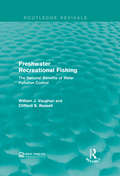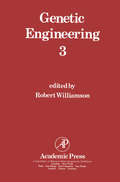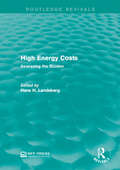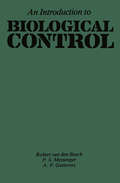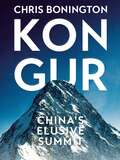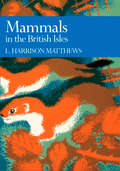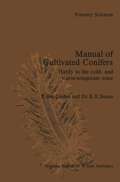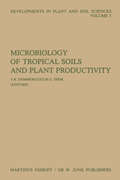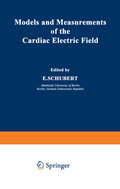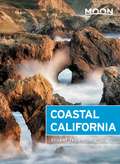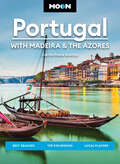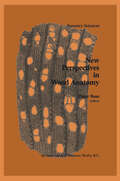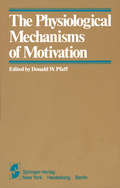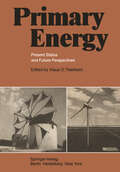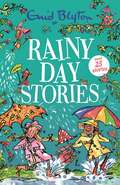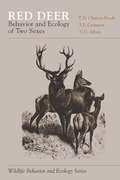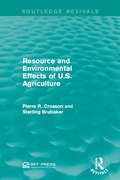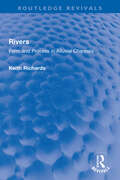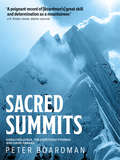- Table View
- List View
Freshwater Recreational Fishing: The National Benefits of Water Pollution Control (Routledge Revivals)
by William J. Vaughan Clifford S. RussellThe Federal Water Pollution Control Act, signed into law in 1972, dramatically redirected the nation’s water pollution control efforts and set out ambitious national goals, expressed both in terms of discharge controls and of resulting water quality. Originally published in 1982, this title examines the benefits that a reduction in the discharge of water pollutants has for recreational fisherman including an increase in the total availability of fishable natural water bodies and an improvement in the aesthetic quality of the fishing experience. It is a valuable resource for students interested in environmental studies and public policy making.
Genetic Engineering 3 (Genetic Engineering: Principles and Methods)
by Robert WilliamsonLike many genetic engineers, I have recently been receiving the atten tion of various venture capital companies, international drug houses and Members of Parliament. I will not discuss which of these approaches are most welcome, but it did cause me to consider the speed of advance in genetic engineering, and the implications of this rapid growth. There were few who anticipated it - only five years ago, most scientists thought applications would come at the end of the century, yet we see products such as insulin and interferon already available for clinical testing. In Europe in general and Britain in particular, this explosive growth in our own field has coincided with a general industrial depression and a marked reduction in funding for biomedical research. The brain drain from Britain is a serious matter, for we are losing the best of our younger scientists, on whom we would rely to train the next generation of molecular biologists. These volumes have come from British labs (mostly because I happen to be based in London, and my contacts and friends are here), and I feel that the quality of the con tributions also shows that our current research is of a high standard.
High Energy Costs: Assessing the Burden (Routledge Revivals)
by Hans H. LandsbergThe two major concerns in the energy policy debate relate to economic efficiency and whether the price should indicate to each consumer the true cost to the economy of using more energy, and the second is that of economic equity where it is argued that energy is a basic necessity for survival and the government has the responsibility to provide assistance for lower-income families. Originally published in 1982, this volume focuses on the uneven impact of rising energy costs on different income groups, regions, and household locations. This collection of papers helps to fill the knowledge gaps about the amount and distribution of household energy expenditure. The volume is organised with a paper introducing each topic followed by one or two discussants’ remarks further examining the issues at hand. It is a valuable title for students interested in environmental studies and national policy.
High Energy Costs: Assessing the Burden (Routledge Revivals)
by Hans H. LandsbergThe two major concerns in the energy policy debate relate to economic efficiency and whether the price should indicate to each consumer the true cost to the economy of using more energy, and the second is that of economic equity where it is argued that energy is a basic necessity for survival and the government has the responsibility to provide assistance for lower-income families. Originally published in 1982, this volume focuses on the uneven impact of rising energy costs on different income groups, regions, and household locations. This collection of papers helps to fill the knowledge gaps about the amount and distribution of household energy expenditure. The volume is organised with a paper introducing each topic followed by one or two discussants’ remarks further examining the issues at hand. It is a valuable title for students interested in environmental studies and national policy.
An Introduction to Biological Control
by A.P. Gutierrez P.S. Messenger R. van den BoschThis volume is a revision of Biological Control by R. van den Bosch and P. S. Messenger, originally published by Intext Publishers. In the revision, I have attempted to keep the original theme, and to update it with current research findings and new chapters or sections on insect pathology, microbial control of weeds and plant pathogens, population dynamics, integrated pest management, and economics. The book was written as an undergraduate text, and not as a complete review of the subject area. Various more comprehen sive volumes have been written to serve as handbooks for the experts. This book is designed to provide a concise overview of the complex and valuable field of biological control and to show the relationships to the developing concepts of integrated pest management. Population regulation of pests by natural enemies is the major theme of the book, but other biological methods of pest control are also discussed. The chapter on population dynamics assumes a precalculus-level knowledge of mathematics. Author names of species are listed only once in the text, but all are listed in the Appendix. Any errors or omissions in this volume are my sole responsibility. A. P. Gutierrez Professor of Entomology Division of Biological Control University of California, Berkeley vii Acknowledgments Very special thanks must be given to my colleagues, Professors C. B. Huffaker and L. E. Caltagirone, for the very thorough review they provided and for the many positive suggestions they gave. Dr.
Kongur: China's Elusive Summit
by Chris Bonington‘It was Kongur that dominated everything, and was the focus of our gaze and aspirations.’So thought Chris Bonington upon the Chinese Mountaineering Association's decision to open many of Tibet and China's mountains to foreigners in the 1980s. Not only did this mean that Kongur, China’s 7,719-metre peak, was available to climb, but that those choosing to do so would be among the first to set foot there. It was an opportunity too good to miss.For the planned alpine-style ascent of this daunting peak, Bonington assembled a formidable team, including Peter Boardman, Joe Tasker, Al Rouse and expedition leader Michael Ward. Their reconnaissance and 1981 expedition brought opportunity for discovery and obstacles in equal measure: they were able to explore areas that had eluded westerners since Eric Shipton’s role as British Consul General in Kashgar in the 1940s; but appalling weather, unplanned bivouacs and tensions characterised their quest for the ever-elusive route to the summit.Featuring diary extracts and recollections from each team member, this account not only captures the gripping detail of the ascent attempts, but also the ebb and flow of the relationships between the remarkable mountaineers involved. Add to this the pioneering medical work on high-altitude illnesses conducted by the four-man medical team, and the result is a book which captures a unique moment in mountaineering history.Written with the cheer and eloquence typical of Chris Bonington, Kongur captures the essence of adventure and exploration that brings readers back to his books time and time again.
Mammals in the British Isles (Collins New Naturalist Library #68)
by L. Harrison MatthewsMammals in the British Isles looks at the influences on their numbers and distribution, both now and in the past, examines aspects of their biology with emphasis on function and physiology, and concludes with an account of relationships with man.
Manual of Cultivated Conifers: Hardy in the Cold- and Warm-Temperature Zone (Forestry Sciences #4)
by P. den Ouden B.K. BoomAs an introduction to the present book I would like to explain how it was, that I, a commercial nurseryman, became so keenly interested in Conifers and their nomen clature. In August 1924 the Dutch Dendrological Society was founded and at the same time a Committee for Nomenclature of woody plants was set up and I served on this committee as one of the members. Our first activity was to bring the catalogues of the various leading nurserymen in the Netherlands into line with the International Rules of Botanical Nomenclature and also to check their nursery stock. Formerly these catalogues had shown a rather confused nomenclature, nurserymen having usually made use of a variety of inconsistent books as guides in compiling their catalogues. In the course of the work a close co-operation between scientific and practical workers developed. Although I had also fully contributed to the correct naming of hardy shrubs and perennials, 1 was most interested in Conifers. I had tried out several species, had grown a wide choice of garden forms and selected types of particular merit for propagation. My special love for Conifers lead to the publication of my Name-list of Conifers (1937), which was adopted as a standard for varietal names at the International Horticultural Congress in Berlin (1938). Later I prepared my book 'Coniferen, Ephedra en Ginkgo' in the Dutch language (1949); compiling the Conifers cultivated or known to be grown in the Netherlands and Belgium at that time.
Microbiology of Tropical Soils and Plant Productivity (Developments in Plant and Soil Sciences #5)
by Y. R. Dommergues G. H. DiemIt is an established fact that we must continually increase and improve agricultural production if we are to meet even the minimum requirements of a growing popu lation for food, shelter, and fuel. In recent years, the introduction of new plant varieties and the extensive use of fertilizers have effectively increased crop yields, but intensifying agricultural methods has often led to depleting soil fertility. Two examples of the harmful consequences of intensive farming practices are the loss of up to 2.5 cm of topsoil every 15 years in the United States through erosion and the alarming rise in environmental pollution through widespread use of pesticides. Countless other processes affecting the activity of soil micro flora and the inter actions between microorganisms and plants may pose an equal danger to soil equilibrium, but their potential hazards are often overlooked because of an insufficient understanding of soil microbiology on the part of scientists. In the first published study of its kind, the authors of this book have attempted to address major aspects of the microbial activity of soil in the tropics. Tropical conditions serve as an ideal context for a discussion of soil microbiology, since biological processes in the soil are particularly active in tropical environments in comparison to other settings and in relation to physical and chemical processes.
Models and Measurements of the Cardiac Electric Field
by E. SchubertThe electric field of the heart was described diagrammatically for the first time by A. Waller in 1888. However, it was not until a little more than ten years ago that with the development of micro electronic techniques, it became accessible to biophysical modeling, to exact physiological measurements, and to application in advanced clinical diagnosis. These possibilities opened the way to the treatment of questions which are called the direct and the inverse solution of the cardioelectric problem. Several groups of investigators are now working to achieve a complete biophysical and physiological description of the generation of the cardiac electric field. This work could well form the basis for a new method of diagnostic measurements, with applications even in clinical cardiology, delivering important information by a non invasive investigation of the patient. Several conferences have stimulated international exchange of the results of research on the cardiac electric field. Among others, the satellite symposium of the XXV International Congress of Physio logical Sciences on the electric field of the heart, in Brussels, August 2-3, 1971, and the Conference on Measuring and Modeling of the cardiac electric field, in Smolenice near Bratislava, June 14- 17, 1976, may be considered predecessors of the Dresden symposium the proceedings of which are presented in this volume.
Moon Coastal California (Travel Guide)
by Stuart ThorntonFrom foggy cliffs and towering redwoods to warm sands and legendary surf, explore the best of the golden coast with Moon Coastal California. Inside you'll find:Flexible itineraries including six days in Central California, five days on the North Coast, and multiple road trip itineraries that can be combined into an epic two-week Pacific Coast road tripStrategic advice for families, adventure seekers, romantic getaways, outdoor enthusiasts, foodies, and moreThe top beaches for surfing, wildlife viewing, solitude, scuba diving, snorkeling, hiking, and moreUnique experiences and can't-miss highlights: Soak up the solitude and rugged beauty of the North Coast beaches, or opt for sun and sand in San Diego. Explore the world-class museums and plunging city streets of San Francisco, sip your way through Napa and Sonoma, or gaze at skyscraping redwoods in Muir Woods. Catch a wave in a classic surf town, explore sea caves by kayak, or hike winding cliffside trails. Feast on local Dungeness crab, sample stouts at a coastal microbrewery, or find the best tacos in Los Angeles Full-color photos and detailed maps throughoutExpert advice from Monterey local and surfer Stuart Thornton on where to stay, where to eat, and how to get aroundBackground information on California's landscape, plants and animals, history, and cultureHandy tips for international visitors, seniors, families with kids, LGBTQ+ travelers, and travelers with disabilities With Moon Coastal California's local insight and practical know-how, you can plan your trip your way.Hitting the road? Try Moon California Road Trip. Headed to the national parks? Check out Moon Death Valley National Park or Moon Yosemite, Sequoia & Kings Canyon.
Moon Portugal: Best Beaches, Top Excursions, Local Flavors (Travel Guide)
by Carrie-Marie BratleyFrom trendy cities to classic fishing villages, soak up the romance of this charming country with Moon Portugal. Inside you'll find: Strategic, flexible itineraries including a two-week tour of the best of Portugal, a five-day trip to charming villages, and more Must-see highlights and unique experiences: Relax on a beach sipping vinho verde and snacking on freshly grilled sardines (a Portuguese classic!). Shop for hand-painted tiles or authentic leather goods, visit the famous Port wine cellars, or browse contemporary galleries and museums along Lisbon's cosmopolitan avenues. Savor a romantic meal on cobblestone esplanades and catch a traditional fado show in an intimate bar. Explore the Roman ruins in Évora, trek majestic mountain ranges, cruise the Sado River, or soak in a volcanic hot spring Trusted local advice from long-time Portugal resident Carrie-Marie Bratley Full-color photos and detailed maps throughoutBackground information on Portugal's landscape, history, and cultural customs In-depth coverage of Lisbon, the Algarve, the Alentejo, Porto and Northern Portugal, Coimbra and Central Portugal, and the Azores and Madeira Handy tools such as visa information, a Portuguese phrasebook, and tips for traveling with children or as a senior With Moon Portugal's practical tips and local insight, you can plan your trip your way. Exploring more of Portugal? Check out Moon Azores. About Moon Travel Guides: Moon was founded in 1973 to empower independent, active, and conscious travel. We prioritize local businesses, outdoor recreation, and traveling strategically and sustainably. Moon Travel Guides are written by local, expert authors with great stories to tell—and they can't wait to share their favorite places with you. For more inspiration, follow @moonguides on social media.
The Natural Environment and the Biogeochemical Cycles (The Handbook of Environmental Chemistry #1 / 1B)
by H. J. BolleEnvironmental Chemistry is a relatively young science. loteTest in this subject, however, is growing very rapidly and, although no agreement has been reached as yet about the exact content and limits of this interdisciplinary discipline, there appears to be increasing interest in seeing environmental topies which are based on chemistry embodied in this subject. One of the first objectives of Environmental Chemistry must be the study of the environment and of natural chemieal processes which occur in the environment. A major purpose of this series on Environmental Chemistry, therefore, is to present a reasonably uniform view of various aspects of the chemistry of the environment and chemical reactions occurring in the environment. The industrial activities of man have given a new dimension to Environmental Chemistry. We have now synthesized and described over five million chemical compounds and chemical industry produces about hundred and fifty million tons of synthetic chemicals annually. We ship billions of tons of oil per year and through mining operations and other geophysieal modifications, large quantities of inorganic and organic materials are released from their natural deposits. Cities and metropolitan areas of up to 15 million inhabitants produce targe quantities of waste in relatively small and confined areas. Much of the chemical products and waste products of modern society are released into the environment either during production, storage, transport, use or ultimate disposal. These released materials participate in natural cycles and reactions and frequently lead to interference and disturbance of natural systems.
New Perspectives in Wood Anatomy: Published on the Occasion of the 50th Anniversary of the International Association of Wood Anatomists (Forestry Sciences #1)
by P. BaasOn the occasion of the 50th Anniversary of the International Association of Wood Anatomists several symposia were held during the 13th International Botanical Congress in Sydney, August 1981. Extended versions of most of the invited papers presented there, and some additional papers on aspects which could not be included in the congress program constitute the contents of this book, which intentionally received the pretentious title 'New Perspectives in Wood Anatomy'. To some readers it may seem a paradox that under this heading papers on a diversity of partly traditional wood anatomical subjects are assembled, even including two with a historical emphasis. However, a study of the history of wood anatomy and of how students of that discipline joined forces in an inter national association, brings to light many facts and views which deserve the attention of present day and future wood scientists as a potential source of in spiration for their research and organisational work.
Oil Prices, Energy Security, and Import Policy (Routledge Revivals)
by Douglas R. Bohi W. David MontgomeryThis book, first published in 1982, takes the interaction between the domestic economy and the international trade in oil and, through the use of a consistent microeconomic framework, examines the conditions under which energy and related policies may or may not improve the performance of the U.S. economy, during both normal periods and old supply disruptions. This title will be of interests to students of environmental management.
Oil Prices, Energy Security, and Import Policy (Routledge Revivals)
by Douglas R. Bohi W. David MontgomeryThis book, first published in 1982, takes the interaction between the domestic economy and the international trade in oil and, through the use of a consistent microeconomic framework, examines the conditions under which energy and related policies may or may not improve the performance of the U.S. economy, during both normal periods and old supply disruptions. This title will be of interests to students of environmental management.
The Physiological Mechanisms of Motivation
by D. W. PfaffTo scientists engaged in research on the cellular mechanisms in the mammalian brain, concepts of "motivation" seem to be a logical neces sity, even if they are not fashionable. Immersed in the detailed, time consuming research required to deal with mammalian nerve cells, we usually pay scant attention to the more global brain -behavior questions that have arisen from decades of biological and psychological studies. We felt it was time to confront these issues-namely, how far has neuro biological investigation come in uncovering mechanisms by which moti vational signals influence behavior? At Rockefeller University, we have recently held a course on this subject. We restricted our treatment to those motivational systems most tractable to physiological approaches, and invited scientists skilled in both behavioral issues and physiological techniques to participate. This volume results from that course. The deans and administration at Rockefeller University provided much help in planning the course, and the staff of Springer-Verlag assisted in planning the book. Gabriele Zummer helped organize both the course and the processing of book chapters. They all deserve our thanks. December 1981 Donald W. Pfaff Professor of Neurobiology and Behavior Rockefeller University Contents Part One: Concepts. . . . . . . . . . . . . . . . . . . . . . . . . . . . . . . . . . . 1 Chapter 1 Donald W. Pfaff Motivational Concepts: Definitions and Distinctions . . . . . . . . . . 3 Motivation: A Brief Review of Concepts. . . . . . . . . . . . . . . . . . . . . . . . . . 5 Drive . . . . . . . . . . . . . . . . . . . . . . . . . . . . . . . . . . . . . . . . . . . . . . . . . . . . . . . . . . 10 Reinforcement, Reward . . . . . . . . . . . . . . . . . . . . . . . . . . . . . . . . . . . . . . . . . 13 Incentive . . . . . . . . . . . . . . . . . . . . . . . . . . . . . . . . . . . . . . . . . . . . . . . . . . . . . . 16 Arousal . . . . . . . . . . . . . . . . . . . . . . . . . . . . . . . . . . . . . . . . . . . . . . . . . . . . . . . 17 Emotion . . . . . . . . . . . . . . . . . . . . . . . . . . . . . . . . . . . . . . . . . . . . . . . . . . . . . . . 18 Motivation Is a Unitary Behavioral Concept with Multiple Neurophysiological Mechanisms. . . . . . . . . . . . . . . . . . . . . . . . . . . . . . . . . 20 References . . . . . . . . . . . . . . . . . . . . . . . . . . . . . . . . . . . . . . . . . . . . . . . . . . . . . 22 Chapter 2 Alan N.
Primary Energy: Present Status and Future Perspectives
by Klaus O. ThielheimThe enormous public interest of specialists as well as of engaged and concerned citizens in the energy problem can be understood in view of the fact that the future of national and world-wide economy depends on the availability of sufficient primary energy. The questions arising are: which forms of primary energy exist principally? by what means and at what cost can they be brought to useful application? and what is their possible role in the present and future energy scenario? Another reason which may not be so obvious, but which eventually may prove to be of great importance as far as public acceptance of energy technologies is con cerned, lies in the fact that the existing conscious or subconscious fears arising from confrontation with scientific and technological progress - to which even for the educated layman intellectual access is diffi cult - have been sublimated onto the energy problem and especially onto the problem of nuclear energy. Un like other developments, the emergence of nuclear ener gy has brought to our notice the ambivalence of ad vancing science and technology, which may either be used peacefully or misused militarily. Nuclear energy can help to overcome the increasing hunger for energy in the world, but it can also lead to the extinction of human life from the surface of this plant. More and more, mankind is confronted with chances and risks of new discoveries.
Rainy Day Stories: Rainy Day Stories (Bumper Short Story Colle Ser.)
by Enid BlytonPull on your welly boots for these short stories by the world's best-loved story teller. Ideal for children aged 5 and up!In this charming collection by Enid Blyton, children stumble upon secret rooms on rainy days and gnomes pretend they can forecast the weather. The rain may be pouring down in these stories, but there's plenty of mischief and adventure to be found. These classic tales are ideal for younger children being read to and for newly confident readers to read alone. Each story stands alone and is the perfect length for reading at bedtime or in the classroom. Enid Blyton remains one of Britain's favourite children's authors and her bumper short story collections are perfect for introducing her to the latest generation of readers. Read all of Enid Blyton's bumper short story collections. New in 2021: Rainy Day StoriesPet StoriesStories of Spells and EnchantmentsChristmas Tales *** Enid Blyton® and Enid Blyton's signature are registered trade marks of Hodder & Stoughton Limited. No trade mark or copyrighted material may be reproduced without the express written permission of the trade mark and copyright owner.
Red Deer: Behavior and Ecology of Two Sexes (Wildlife Behavior and Ecology series)
by T. H. Clutton-Brock F. E. Guinness S. D. AlbonRed Deer: Behavior and Ecology of Two Sexes is the most extensive study yet available of reproduction in wild vertebrate. The authors synthesize data collected over ten years on a population of individually recognizable red deer, usually regarded as conspecific with the American elk. Their results reveal the extent of sex differences in behavior, reproduction, and ecology and make a substantial contribution to our understanding of sexual selection.
Resource and Environmental Effects of U.S. Agriculture (Routledge Revivals)
by Pierre R. Crosson Sterling BrubakerOriginally published in 1982, this report explores long-term trends in demand for U.S. agricultural production, energy prices and agricultural technologies and their effect on natural resources such as land and water in the United States. Crosson and Brubaker also discuss possible policy modifications in order to lessen the environmental impacts expected to emerge from these trends. This title will be of interest to students of Environmental Studies.
Resource and Environmental Effects of U.S. Agriculture (Routledge Revivals)
by Pierre R. Crosson Sterling BrubakerOriginally published in 1982, this report explores long-term trends in demand for U.S. agricultural production, energy prices and agricultural technologies and their effect on natural resources such as land and water in the United States. Crosson and Brubaker also discuss possible policy modifications in order to lessen the environmental impacts expected to emerge from these trends. This title will be of interest to students of Environmental Studies.
Rivers: Form and Process in Alluvial Channels (Routledge Revivals)
by Keith RichardsOriginally published in 1982, this book presents a detailed review of alluvial river form and process and integrates the distinct but related approaches of geomorphologists, geologists and engineers to the subject. It outlines the environmental catchment factors that control the development of channel equilibrium and provides a detailed account of the sediment transport processes that represent the physical mechanisms by which channel adjustment occurs. Where possible it evaluates theoretical analyses in the context of the empirical evidence. Rivers should prove a valuable textbook for geomorphology students on advanced undergraduate courses on river behaviour and will also be of interest to students of hydraulics and sedimentology and to those concerned with civil and environmental engineering, river management and channel design, maintenance and management in the water industry
Rivers: Form and Process in Alluvial Channels (Routledge Revivals)
by Keith RichardsOriginally published in 1982, this book presents a detailed review of alluvial river form and process and integrates the distinct but related approaches of geomorphologists, geologists and engineers to the subject. It outlines the environmental catchment factors that control the development of channel equilibrium and provides a detailed account of the sediment transport processes that represent the physical mechanisms by which channel adjustment occurs. Where possible it evaluates theoretical analyses in the context of the empirical evidence. Rivers should prove a valuable textbook for geomorphology students on advanced undergraduate courses on river behaviour and will also be of interest to students of hydraulics and sedimentology and to those concerned with civil and environmental engineering, river management and channel design, maintenance and management in the water industry
Sacred Summits: The Carstensz Pyramid, Kangchenjunga and Gauri Sankar
by Peter BoardmanMountaintops have long been seen as sacred places, home to gods and dreams. In one climbing year Peter Boardman visited three very different sacred mountains. He began on the South Face of the Carstensz Pyramid in New Guinea. This is the highest point between the Andes and the Himalaya, and one of the most inaccessible, rising above thick jungle inhabited by warring Stone Age tribes.During the spring Boardman made a four-man, oxygen-free attempt on the world's third highest peak, Kangchenjunga. Hurricane-force winds beat back their first two bids on the unclimbed North Ridge, but they eventually stood within feet of the summit – leaving the final few yards untrodden in deference to the inhabiting deity. In October, he climbed the mountain most sacred to the Sherpas: the twin-summited Gauri Sankar. Renowned for its technical difficulty and spectacular profile, it is aptly dubbed the Eiger of the Himalaya and Boardman's first ascent took a gruelling twenty-three days.Three sacred mountains, three very different expeditions, all superbly captured by Boardman in Sacred Summits, his second book, first published shortly after his death in 1982. Combining the excitement of extreme climbing with acute observation of life in the mountains, this is an amusing, dramatic, poignant and thought-provoking book.Peter Boardman and Joe Tasker died on Everest in 1982, whilst attempting a new and unclimbed line. Both men were superb mountaineers and talented writers. Their literary legacy lives on through the Boardman Tasker Prize for Mountain Literature, established by family and friends in 1983 and presented annually to the author or co-authors of an original work which has made an outstanding contribution to mountain literature.
